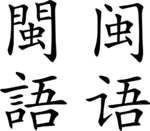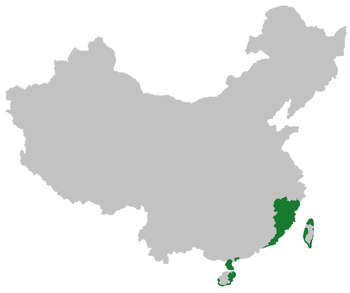- Min Chinese
-
Min Chinese 
Bân gú / Mìng ngṳ̄ ('Min') written in
Chinese charactersTraditional Chinese 閩語 Simplified Chinese 闽语 Hokkien POJ Bân gú Transcriptions Mandarin - Hanyu Pinyin Mǐn Yǔ Min - Hokkien POJ Bân gú - Min-dong BUC Mìng ngṳ̄ Min 閩語/闽语 Geographic
distribution:Mainland China: Fujian, Guangdong (around Chaozhou-Swatou and Leizhou peninsula), Hainan, Zhejiang-Shengsi, Putuo and Wenzhou, Jiangsu- Liyang and Jiangyin; Taiwan (Overseas, United States-New York City) Linguistic classification: Sino-Tibetan - Sinitic
- Chinese
- Min
- Chinese
Subdivisions: 
 A map of the primary varieties of Min.
A map of the primary varieties of Min.
Mǐn or Miin[1] (simplified Chinese: 闽语; traditional Chinese: 閩語; pinyin: Mǐn yǔ; Pe̍h-ōe-jī: Bân gú; BUC: Mìng ngṳ̄) is the name of a broad group of Chinese languages spoken by 60 million people in the southeastern Chinese province of Fujian as well as by migrants from this province in Guangdong (around Chaozhou-Swatou, or Chaoshan area, and the Leizhou peninsula), Hainan, three counties in southern Zhejiang, and Zhoushan archipelago off Ningbo, and some towns in Liyang and Jiangyin city in Jiangsu province, and Taiwan. There are many Min speakers also among overseas Chinese in Southeast Asia as well as in New York City in the United States. The most widely spoken variety of Min outside Fujian (the Min Province) is Hokkien, which includes Taiwanese and Amoy, amongst other dialects; while in Fujian, Min Dong is considered the standard. The Min dialects preserve many of the archaic pronunciations of Old Chinese.[2][not in citation given]
Contents
Varieties
Min has greater dialectal diversity than any other division of Chinese. It is typically divided, on the basis of mutual intelligibility, into five to nine languages, such as Min Dong (Eastern Min) and Min Nan (Southern Min). Phylogenetically, there is a primary split between an Inland Min group consisting of Shao-Jiang Min (disputed), Min Bei, and Min Zhong and a Coastal Min consisting of Min Dong, Pu-Xian Min, Min Nan, and Qiong Wen. Shaojiang Min may also be classified as an outgroup within Min Chinese branching off first from the other Min languages.
Min Dong is centered around the city of Fuzhou (Fuzhou dialect is the standard dialect of Min Dong), capital of Fujian province, while Min Nan is dominant in the south of Fujian and into eastern Guangdong. Pu-Xian Min originated as a Min Nan dialect which underwent major phonological influence from Fuzhou Min Dong. Similarly, Qiong Wen, spoken in Hainan, is sometimes classed as a separate language; it originated from a Min Nan dialect that underwent major phonological shifts over time.
Min-Nan is also called by the name of its regional variants in the places it is spoken, especially Taiwanese. The Amoy dialect of Xiamen is the prestige dialect of Min Nan in mainland China and Taiwan, with Teochew also being an important variety.
Glossika divides the Min languages into eight: Northern Min (Min Bei in Nanping prefecture in Fujian, but Jian'ou dialect is the standard dialect of Min Bei), Shaojiang (eastern Nanping and surrounding areas; in broader classifications treated as a dialect of Min Bei), Eastern Min (Min Dong in Fuzhou and Ningde prefectures), Central Min (Min Zhong in Sanming prefecture), Puxian Min in Putian prefecture, Southern Min (Min Nan in Zhangzhou, Quanzhou, and Xiamen (Amoy) prefectures and on Taiwan (Hokkien dialect), and in eastern Guangdong province (Teochew dialect); Hokkien and Teochew are sometimes considered separate languages), Leizhou (on the Leizhou Peninsula in Guangdong), and Hainanese (on Hainan Island; in broader classifications Leizhou and Hainanese are treated as a Qiongwen language or as dialects of Min Nan).
The Southern Min language in Guangdong is known as Hoklo, in Hainan as Qiong Wen or Qiongzhou hua (though some class Qiong Wen as a separate sub-group). Min Nan is the dominant Chinese dialect spoken by the Chinese minority in the Philippines, where it is known as Lan-nang. In Taiwan, Min Nan is known as Hō-ló-oē and is spoken by the majority of the population as their native language. In Singapore, Malaysia, Indonesia and other areas in Southeast Asia, Min Nan is known as Hokkien, in addition to the Teochew variant, originating in the Chaoshan region, which is the ancestral home of many ethnic Chinese in Singapore as well as in Bangkok, Thailand (see Thai Chinese for more information about the Chinese community in Thailand).
Min Inland Min Northwestern Min Bei (Nanping prefecture) Jianyang
Jianou
Songxi
Shibei
Shaojiang (disputed)[nb 1] Shaowu
Jiangle
Min Zhong (Sanming prefecture) Sanming
Yong'an
Shaxian
Coastal Min Northeastern Manhua
Mindong Ningde (Ningde prefecture)
Youxi
Southern Min Nan Hokkien Amoy/Taiwanese
Datian
Puxian Xianyou
Qiong-Lei Leizhou
History
There are controversies among scholars about when Min Chinese was initially formed. But it is generally consensus that several huge immigrations from Zhongyuan greatly shaped and influenced Min Chinese.
- In 308 AD (晋永嘉二年), a big immigration from north to south happened in China because of Wu Hu uprising (more commonly referred in Chinese as 永嘉之乱). Sanshanzhi (三山志) stated that the population in Jinjiang county almost doubled. The tide of immigration brought the Chinese spoken in Jin Dynasty to Fujian.[3][4]
- In 669 AD, Chen Zheng and his son Chen Yuanguang from Gushi County in Henan set up a regional administration in Fujian and governed the area of Quanzhou and Zhangzhou for four generations.[5] They brought with them the Chinese spoken in early Tang Dynasty.
- During Tang Dynasty, following the development of Imperial examination (科舉), Qieyun's vowel system was introduced into Min Chinese.[6]
- At the end of Tang Dynasty, in 892 AD, Wang Chao was appointed jiedushi of Fujian and his brother Wang Shenzhi founded Min Kingdom in 909 AD following the fall of Tang Dynasty. Min Kingdom was one of the Ten Kingdoms in Five Dynasties and Ten Kingdoms Period. Wang Chao and Wang Shenzhi were also from Gushi County in Henan and the Chinese spoken in late Tang Dynasty entered Fujian.
Writing system
See also: Written HokkienWhen using Chinese characters to write a non-Mandarin form, standard practice is to use characters that correspond etymologically to the words being represented, and to invent new characters for words with no evident ancient Chinese etymology or in some cases for alternative pronunciations of existing characters, especially when the meaning is significantly different. Written Cantonese has carried this process out to the farther extent of any non-Mandarin variety, to the extent that pure Cantonese vernacular can be unambiguously written using Chinese characters. Contrary to popular belief, a vernacular written in this fashion is not in general comprehensible to a Mandarin speaker, due to significant changes in grammar and vocabulary and the necessary use of large number of non-Mandarin characters.
A similar process has never taken place for any of the Min languages and there is no standard system for writing Min, although some specialized characters have been created. Given that Min combines Chinese languages from several different periods and contains some non-Chinese vocabulary, one may have trouble finding the appropriate Chinese characters for some Min vocabulary. In the case of Taiwanese, there are also indigenous words loaned from the Taiwanese aborigines, as well as a substantial number of loan words from Japanese. In Singapore and Malaysia, the Min variants spoken have borrowed heavily from Malay and to a lesser extent, from English and other languages. The result is that cases of Min languages written purely in Chinese characters do not represent actual Min speech, but contain a heavy mixture of Mandarin forms.
Attempts to faithfully represent Min speech necessarily rely on romanization, i.e. representation using Latin characters. Some Min speakers use the Church Romanization (Chinese: 教會羅馬字; pinyin: Jiaohui Luomazi). For Min Nan the romanization is called Pe̍h-ōe-jī (POJ) and for Min Dong called Bàng-uâ-cê (BUC). Both systems were created by foreign missionaries in the 19th century (see Min Nan and Min Dong Wikipedia). There are some uncommon publications in mixed writing, using mostly Chinese characters but using the Latin alphabet to represent words that cannot easily be represented by Chinese characters.
See also
Notes
- ^ While it is usually classified with Minbei, sometimes it's excluded from Min and classified as Gan instead
References
- ^ The double ii represents the dipping tone in Mandarin, as in the province of Shaanxi.
- ^ Mei Tsu-lin (1970). "Tones and Prosody in Middle Chinese and The Origin of The Rising Tone." Harvard Journal of Asiatic Studies 30:86–110
- ^ 《晉書•地理志》“閩越遐阻,僻在一隅。永嘉之後,帝室東遷,衣冠避難,多所萃止。“
- ^ 《閩書》 “衣冠始入閩者八族,所謂林、黄、陳、鄭、詹、丘、胡是也。”
- ^ 《汉语方言学基础教程》, 李小凡, page 52, “唐初,陈政、陈元光父子四代驻守闽南漳、泉二州。“
- ^ 《汉语方言学基础教程》, 李小凡, page 52, “唐朝科举兴盛,崇尚文教,《切韵》音系作为文读系统也进入了闽语。“
Further reading
- Branner, David Prager (2000). Problems in Comparative Chinese Dialectology — the Classification of Miin and Hakka. Trends in Linguistics series, no. 123. Berlin: Mouton de Gruyter. ISBN 31-101-5831-0.
- DeBernardi, J. E. (1991). "Linguistic nationalism--the case of Southern Min". Order from Dept. of Oriental Studies, University of Pennsylvania..
External links
- Classification of Min Dialects
- Min Bei Chinese at Ethnologue
- Min Dong Chinese at Ethnologue
- Min Nan Chinese at Ethnologue
- Min Zhong Chinese at Ethnologue
- Pu-Xian Chinese at Ethnologue
- Seaside Min Language Forum (Chinese)
Chinese language(s) Major
subdivisionsNortheastern · Ji-Lu · Jiao-Liao · Zhongyuan · Southwestern · Lan-Yin · Lower Yangtze · Beijing · Dungan · Xuzhou · Luoyang · Jinan · Karamay · Nanking · Sichuanese · Kunming · Shenyang · Harbin · Qingdao · Guanzhong · Dalian · Weihai · Taiwanese Mandarin · Filipino-Mandarin · Malaysian Mandarin · Singaporean Mandarin · Chuan-puYueMinother MinDisputedUnclassifiedStandardized forms
(Ausbausprache)Phonology History Written Chinese OfficialHistorical scriptsOtherList of varieties of ChineseCategories:- Chinese dialects
- Chinese languages in Singapore
- Languages of the Philippines
- Sinitic
Wikimedia Foundation. 2010.
